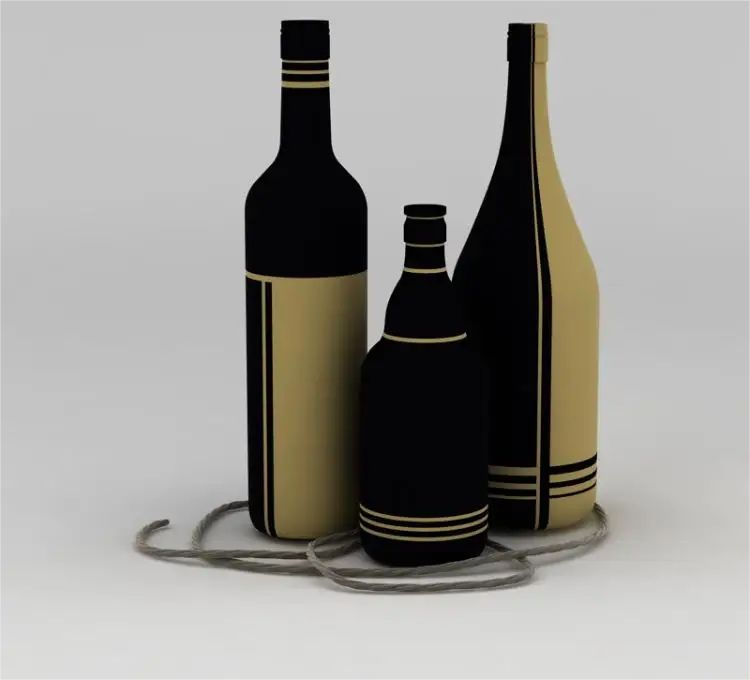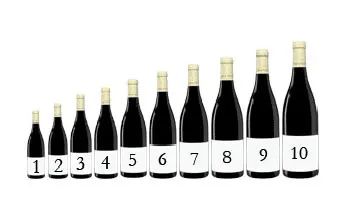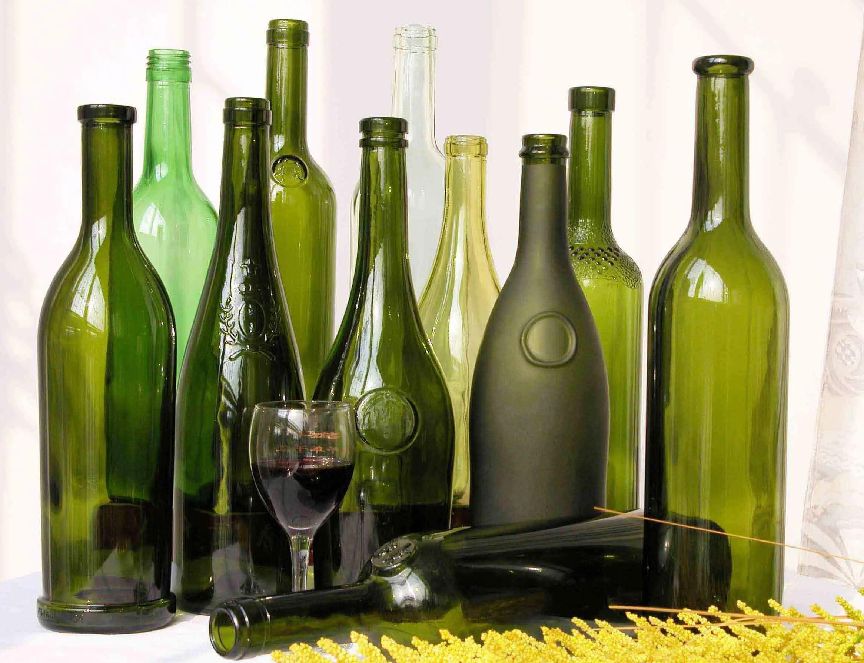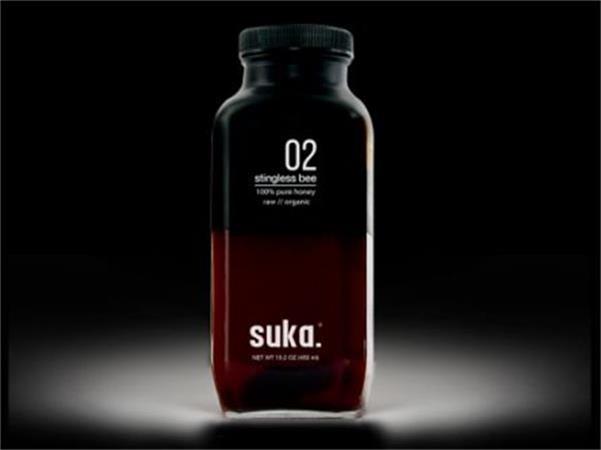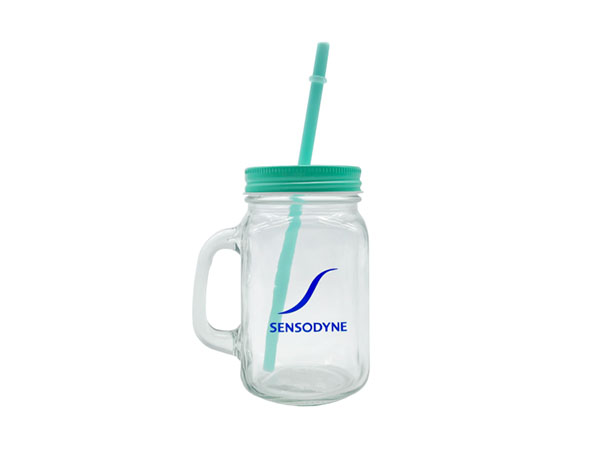Grape bottles with different shapes and colors not only contain delicious wine, but also reveal a lot of information about wine to us from the side.This article will start from the origin of red wine and share the development of the whole red wine bottle.
Before discussing the development of red wine bottles, let's briefly discuss the development history of the whole nine thousand years of red wine.The wine discovered in Iran about 5400 BC was considered to be one of the earliest brewed wines in the world, but the discovery of wine in the ruins of Jiahu in Henan has rewritten this record. According to the current findings, China's brewing history is more than 1000 years earlier than that of foreign countries. That is to say, Jiahu Site, an important site in the early Neolithic Age in China, is also an early winemaking workshop in the world. After chemical analysis of the sediment on the inner wall of the pottery unearthed at the Jiahu site, it was found that people at that time would make fermented rice wine, honey and wine, and they would also store them in pottery pots.In Israel, Georgia, Armenia, Iran and other countries, a batch of large pottery brewing equipment from 4000 BC was found. At that time, people used these buried equipment to brew wine; To this day, Georgia still uses containers in the land to brew wine, which is generally called KVEVRI.On the plaque of ancient Greek Pilos from 1500 to 1200 BC, many information about grape vines and wine is often recorded in linear characters of class B (ancient Greek).
121 BC is called the year of Opimian, which refers to the best wine year in the golden age of ancient Rome. It is said that this wine can still be drunk after 100 years.In 77, Pliny the Elder, an encyclopedic writer in ancient Rome, wrote the famous phrases "Vino Veritas" and "In Wine There Is Truth" in his book "Natural History".
During the 15-16th century, wine was usually bottled in porcelain pots and then fermented again to produce bubbles; This Cremant style is the prototype of French sparkling wine and English cider.At the end of the 16th century, in order to prevent wine from deteriorating during long-distance transportation, people generally extended its life by adding alcohol (reinforcement method). Since then, famous fortified wines such as Port, Sherry, Madeira and Marsala have been made in this way.In the 17th century, in order to better preserve Porter, the Portuguese became the first country to popularize glass bottled wine, inspired by the two ear wine jar recorded in historical records. Unfortunately, the glass bottle at that time could only be placed vertically, so the wooden stopper was easily cracked due to drying, and thus lost its sealing effect.
In Bordeaux, 1949 was a very good year, which was also called the Vintage of the Century.In 1964, the world's first Bag-in-a-Box Wines was born.The first wine exhibition in the world was held in 1967 in Verona, Italy. In the same year, the world's first mechanized harvester was officially commercialized in New York.In 1978, Robert Parker, the most authoritative wine critic in the world, officially founded The Wine Advocate magazine, and his hundred mark system has also become an important reference for consumers to buy wine. Since then, 1982 has been a turning point for Parker's brilliant achievements.
In 2000, France became the world's largest wine producer, followed by Italy.In 2010, Cabernet Sauvignon became the most widely planted grape variety in the world.In 2013, China became the world's largest consumer of dry red wine.
After introducing the development of red wine, let's talk about the development of red wine bottles.The predecessor of glass bottle is pottery pot or stone vessel. It's hard to imagine how ancient people poured out glasses of wine with clumsy clay pots.
In fact, glass was discovered and used as early as Roman times, but glassware at that time was extremely precious and rare, which was very difficult to forge and fragile. At that time, the nobles carefully regarded the hard to get glass as the top grade, and sometimes even wrapped it in gold. It turns out that what the West plays is not gold inlaid with jade, but gold inlaid with "glass"! If we use glass containers to contain wine, it is as incredible as the bottles made of diamond.
The wine discovered in Iran about 5400 BC was considered to be one of the earliest brewed wines in the world, but the discovery of wine in the ruins of Jiahu in Henan has rewritten this record. According to the current findings, China's brewing history is more than 1000 years earlier than that of foreign countries. That is to say, Jiahu Site, an important site in the early Neolithic Age in China, is also an early winemaking workshop in the world. After chemical analysis of the sediment on the inner wall of the pottery unearthed at the Jiahu site, it was found that people at that time would make fermented rice wine, honey and wine, and they would also store them in pottery pots.This continued until the seventeenth century, when coal was discovered. The thermal efficiency of coal is higher than that of rice straw and straw, and the flame temperature can easily reach more than 1000 ℃, so the process cost of forging glass becomes lower and lower. But glass bottles are still rare objects that can only be seen by the upper class at the very beginning. (I really want to carry several bottles of wine through the 17th century to exchange for some gold pimples!) At that time, wine was sold in bulk. People with good economic conditions might have an ancestral glass bottle. Every time they wanted to drink, they took the empty bottle and went to the street to get 20 cents of wine!
The earliest glass bottles were formed by manual blowing, so the bottle will have a great randomness in shape and capacity with the technical proficiency and the vital capacity of each bottle maker. It is precisely because the size of bottles cannot be unified. For a long time, wine was not allowed to be sold in bottles, which would lead to unfair transactions.In the past, when blowing bottles, we needed two cooperation. A person dips one end of a long high temperature resistant tube into the hot glass solution and blows the solution into a mold. An assistant controls the mold switch on the other side. The semi-finished products coming out of the mold like this still need a base, or need two people to cooperate. One person uses a heat-resistant metal rod to hold the bottom of the semi-finished products, and the other person rotates the bottle body while making the bottle bottom produce a uniform and appropriate size base. The original bottle shape is low and prone, which is the result of centrifugal force when the bottle is blown and rotated.
Since the 17th century, the shape of the bottle has changed greatly in the following 200 years. The shape of the bottle has changed from a short onion to a graceful column. To sum up, one of the reasons is that the production of wine has gradually increased, and wine can be stored in bottles. During storage, it was found that those flat scallions occupy a large area and are not convenient for storage, and their shape needs to be further improved; Second, people gradually found that the wine stored in the bottle would be better than the wine just brewed, which is the embryonic form of the modern "wine ripening" theory. The storage in bottle has become a trend, so the shape of the bottle should serve for convenient placement and space saving.
In the era of glass bottle blowing, the volume mainly depends on the vital capacity of the bottle blower. Before the 1970s, the volume of wine bottles varied from 650 ml to 850 ml. Burgundy and champagne bottles are generally large, while sherry and other fortified wine bottles are usually small. It was not until the 1970s that the European Union unified the volume of wine bottles, all of which were replaced by 750ml.In history, the volume of standard wine bottles was not uniform. Until the 1970s, the European Community set the size of standard wine bottles as 750ml in order to promote standardization. At present, 750 ml standard bottles are generally accepted in the world. Before that, the bottles of Burgundy and Champagne were slightly larger than those of Bordeaux, while the bottles of sherry were usually smaller than those of Bordeaux. At present, the standard bottle of some countries is 500ml. For example, the Hungarian Tokai sweet wine is filled in 500ml bottles. In addition to standard bottles, there are bottles smaller or larger than standard bottles.
Although the commonly used standard bottles are 750ml, there are some differences in the description and size of bottles of other capacities between Bordeaux and Champagne.
Although the volume of wine bottles is unified, their body shapes are different, often representing the tradition of each region. The bottle shapes of several common figures are shown in the figure. Therefore, do not ignore the information given by the bottle type, which is often a hint of the wine's origin. For example, in the New World countries, wines made from Pinot Noir and Chardonnay are often put into Burgundy bottles like the origin; In the same way, most of the world's Cabernet Sauvignon and Merlot dry red wines are packed in Bordeaux bottles.
The bottle shape is sometimes a hint of style: Rioja's dry red may be brewed with Tempranillo or Kohena. If there are more Tempranillo in the bottle, manufacturers tend to use bottle shapes similar to Bordeaux to interpret its strong and powerful characteristics. If there are more Gerberas, they prefer to use Burgundy bottle shapes to express its gentle and soft characteristics.
Seeing here, as the white people who were originally enthusiastic about wine, they must have fainted countless times. Because the smell and taste of wine need certain requirements for the sense of smell and taste, which requires a long time of learning and talent for the beginner. But don't worry, we won't talk about the "posture" of smelling aroma and recognizing wine. Today, we present the entry-level wine rookie must GET quick dry goods! That is to identify wine from the shape of the bottle! Attention: In addition to the role of storage and wine bottles also have a certain impact on the quality of wine. The following are the most popular types of wine bottles:
1.Bordeaux bottle
Bordeaux bottle straight shoulders. Bottles of different colors contain different types of wine. Bordeaux bottles have streamline sides, wide shoulders, and three colors: dark green, light green, and colorless: dry red in dark green bottles, dry white in light green bottles, and sweet white in white bottles.This kind of wine bottle is also often used by wine merchants in New World countries to hold Bordeaux mixed style wines, and Italian wines such as Chianti are also commonly used to hold Bordeaux bottles.
The common bottle shape of Bordeaux bottle, with wide shoulder and cylindrical body, makes the sediment difficult to pour out.Two wines with high production and sales volume in the world, Cabernet Sauvignon and Merlot, all use Bordeaux bottles. In Italy, the bottle is also widely used, such as the contemporary Chianti wine.
As this kind of wine bottle is common and easy to bottle, store and transport, it is widely loved by wineries.
2.Burgundy bottle
Burgundy bottle is the most popular and most used wine bottle besides Bordeaux bottle. Burgundy bottle is also called slant shoulder bottle. Its shoulder line is smooth, the bottle body is round, and the bottle body is thick and solid. Burgundy bottle is mainly used to hold Pinot Noir, or red wine similar to Pinot Noir, as well as white wine of Chardonnay. It is worth mentioning that this kind of diagonal shoulder bottle popular in the Rhone Valley of France also has a similar shape to the Burgundian bottle, but the bottle body is slightly higher, the neck is more slender, and usually the bottle is embossed.Oblique shoulder and straight body shape remind people of elderly European gentlemen. The bottle body has a strong sense of streamline, a narrow shoulder, a round and wide body, and a groove at the bottom. The wines usually contained in Burgundy bottles are Chardonnay and Pinot Noir from New World countries. Some full-bodied wines, such as Barolo in Italy, also use Burgundy bottles.
3.Alsace bottle
Slim and slender, like a French blonde with good figure. The bottle in this shape has two colors. The green body is called Alsace bottle, and the brown body is Rhine bottle, and there is no groove at the bottom! The wine contained in this type of wine bottle is relatively diverse, ranging from dry to semi dry to sweet, which can only be identified by the wine label.
4.Champagne bottle
The broad body with sloping shoulders is similar to that of a Burgundian bottle, but it is larger, like a burly guard. The bottom of the bottle usually has a deep depression, which is to withstand the huge pressure generated by the carbonization process in the champagne bottle. The basic sparkling wine is packed in this bottle, because this design can withstand the high pressure in sparkling wine
Most modern wine bottles have darker colors, because the dark environment will avoid the influence of light on the wine quality. But do you know that the reason why the glass bottle had color at the beginning was simply the helpless result that people could not extract the impurities in the glass. But there are also examples of transparent bottles, such as most bright pink, so that you can see her before opening the bottle. Now wine that does not need to be stored is usually stored in colorless bottles, while colored bottles can be used to store aged wine.
Because of the temperature of forged glass in different regions, bottles in most regions show different colors. Brown bottles can be found in certain regions, such as Italy and Rhineland in Germany. In the past, the bottle colors of German Rhineland and Moselle were very different. Rhineland tended to be brown while Moselle tended to be green. But now more and more German wine merchants use green bottles to package their wine, because green is more beautiful? Maybe so!In recent years, another color has been stir fried, that is, "dead leaf color". This is a color between yellow and green. It first appeared on the packaging of Burgundy's Chardonnay white wine. With Chardonnay going around the world, distilleries in other regions also use this dead leaf color to package their wine.
I hope this article can help you better understand the history of red wine and the development of red wine bottles
Post time: Aug-27-2022 Other Blog

